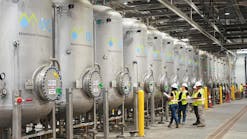Singapore scientists have developed a unique method of removing phosphorus from wastewater at higher temperatures than conventionally possible.
The researchers were with the Singapore Center for Environmental Life Sciences and Engineering (SCELSE) at Nanyang Technological University, Singapore (NTU Singapore) and the National University of Singapore.
The team developed a technique to remove phosphorus from wastewater at higher temperatures than is possible using existing techniques by using bacteria to store the chemical.
Current techniques to remove phosphorus do not work well at temperatures above 25 degrees Celsius, which occur now in warm countries. This is expected to extend to more countries, with the advent of global warming.
Due to the presence of diverse microbial communities in water reclamation plants in Singapore, the new innovation would thus help to ‘future-proof’ the removal of the chemical. This is as the scientists have demonstrated that it has effectively removed phosphorus from wastewater at 30 degrees Celsius and 35 degrees Celsius.
Called Candidatus Accumulibacter, the bacterial genus is not harmful to humans or the environment and removes phosphate from wastewater and stores it internally as polyphosphate granules. The scientists say their method could be used in laboratory-scale reactors and full-scale treatment plants.
Removing phosphorus from wastewater before discharging it into bodies of fresh water is important, as its presence can result in an algal bloom, which is a rapid increase in the population of algae. Algal blooms severely lower oxygen levels in natural waters when the algae die off and sometimes result in the release of high levels of toxins, killing organisms that live within the waters it affects. In Singapore, wastewater is treated at water reclamation plants located near coastal areas before it is discharged into the sea.
Unlike other methods, the SCELSE-developed method to remove phosphorus from wastewater does not involve chemicals, such as iron and aluminium coagulants. These methods produce a large volume of inert sludge that needs to be treated and disposed of afterwards.
The results of the study were published in the journal Water Research in June.
“We have shown that phosphorus could be stably removed in Singapore’s water reclamation plants even as we expect global water temperatures to increase further,” says NTU Professor Stefan Wuertz who led the study. “Employing a slow-feeding strategy and sufficiently high carbon input into biological reactors, we effectively limited the carbon uptake rates of competing bacteria. This allowed Accumulibacter to flourish and benefited a stable and efficient process, representing basic conditions suitable for future full-scale treatment plants. This will help Singapore and other countries experiencing high water temperatures to prepare for the effects of climate change.”
To begin the process, the researchers enriched the bacteria from wastewater in experimental reactors with temperatures from 30 degrees Celsius to 35 degrees Celsius, while ensuring that the pH was around neutral. After a six-hour cycle, the bacteria absorbed the phosphorus completely.
Over a testing period of over 300 days in a laboratory setting, they found that there was consistent removal of phosphorus, coping with the daily infusions of fresh wastewater that contained the element.
The scientists will be carrying out further research to further improve the efficacy of their method. They are also looking towards using the bacteria to capture and store phosphorus for later reuse.



